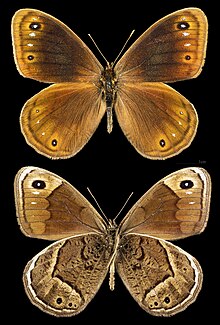
The superfamily Papilionoidea contains all the butterflies except for the moth-like Hedyloidea.

The Satyrinae, the satyrines or satyrids, commonly known as the browns, are a subfamily of the Nymphalidae. They were formerly considered a distinct family, Satyridae. This group contains nearly half of the known diversity of brush-footed butterflies. The true number of the Satyrinae species is estimated to exceed 2,400.
Redonda is a butterfly genus from the subfamily Satyrinae in the family Nymphalidae. The genus was erected by Michael Jan Adams and George Igor Bernard in 1981. It is endemic to the Cordillera de Merida páramo in Mérida, Venezuela. There are 10 known species, which are separated in distinct mountain ranges. Most species show some degree of sexual dimorphism in wing size, in the most extreme cases females show some degree of wing deformation which might point to incipient brachyptery.
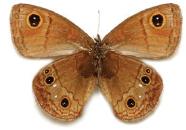
Calisto is a butterfly genus from the subfamily Satyrinae in the family Nymphalidae. The genus was erected by Jacob Hübner in 1823. Members of the genus occur on the Caribbean islands only. Of the 44 species that are currently thought to exist, eleven occur on Cuba, one on Puerto Rico, one on Anegada Island, one on Jamaica, two on the Bahamas and twenty-eight on Hispaniola.

The Satyrini is one of the tribes of the subfamily Satyrinae. It includes about 2200 species and is therefore the largest tribe in the subfamily which comprises 2500 species.

The Elymniini is one of the tribes of the subfamily Satyrinae. If the subfamily Satyrinae elevate to family status, this tribe shall be treated as subfamily Elymniinae. Elymniini was formerly a large group, but recently, it is considered to be include only one genus, Elymnias, according to molecular phylogenetic analyses.

The butterfly subtribe Euptychiina is a diverse group within the tribe Satyrini, occurring throughout Central and South America, in addition to a few species known from North America. Euptychiina is a predominantly lowland group, with the exception of one Asian taxon Palaeonympha opalinaButler, 1871 and the Andean genus ForsterinariaGray, 1973. The taxon was erected by Lee Denmar Miller.
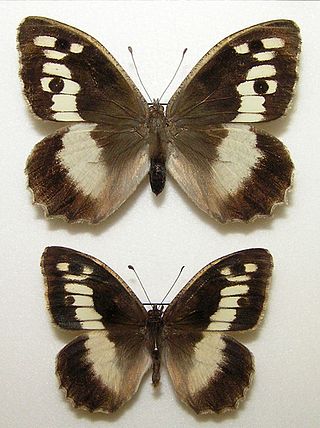
Chazara is a butterfly genus from the subfamily Satyrinae of the brush-footed butterfly family (Nymphalidae). The most well-known is the hermit butterfly. C. briseis can be found as far west as Morocco and as far eastward as Mongolia. They inhabit the Tian Shan mountain range of Central Asia, also known as the Celestial Mountains, which are fabled in Daoist literature as the place where the Goddess of the West attends to the Peaches of Immortality.

Brassolini is a tribe usually placed in the brush-footed butterfly subfamily Morphinae, which is often included in the Satyrinae as a tribe Morphini. If this is accepted, the Brassolini become the sister tribe of the Morphini among the Satyrinae. Formerly, they were treated as an independent family Brassolidae or subfamily Brassolinae. Many members of this tribe are called owl butterflies.
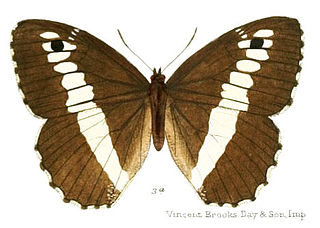
Aulocera is a genus in the subfamily Satyrinae of the brush-footed butterfly family, Nymphalidae. Commonly referred to as banded satyrs, species of the genus Aulocera are endemic to the Himalayas and associated mountain ranges.
Berberia abdelkader, the giant grayling, is a species of butterfly in the family Nymphalidae. It is endemic to the North African region, mainly Morocco, Algeria, and Tunisia. It flies in the vast steppes and the males are easily seen flying in search of a shy female. Usually, females are fertilised as soon as they hatch.
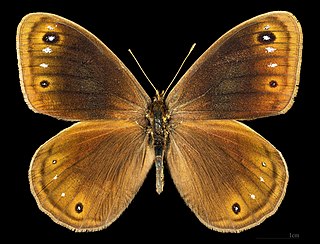
Berberia lambessanus is a species of butterfly in the family Nymphalidae. It is endemic to the North African region, mainly Morocco, Algeria, and Tunisia. It flies in the vast steppes but has a preference for slopes, and the males are easily seen flying in search of a shy female. Usually, females are fertilised as soon as they hatch. The range of Berberia lambessanus overlaps with that of B. abdelkader
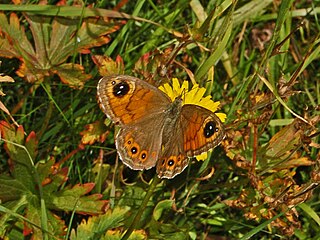
Lasiommata is a genus of butterflies of the subfamily Satyrinae in the family Nymphalidae.
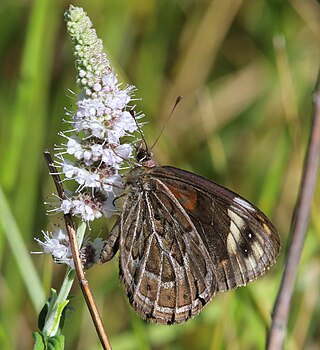
Torynesis is a genus of butterflies from the subfamily Satyrinae in the family Nymphalidae. It comprises five species from South Africa and Lesotho. It is one of the genera in the tribe Dirini Verity, 1953; other genera of this tribe that are found in the Afrotropical Region are Paralethe, Aeropetes, Tarsocera, Dira, Serradinga and Dingana.

Pronophilina is a Neotropical subtribe of butterflies of the subfamily Satyrinae. They are a species-rich group with highest diversity in the tropical and subtropical mountains, especially the Andes. Before 1970, they were poorly studied, but recent interest has resulted in high rates of species description from previously unexplored mountain ranges. However, there is still a lack of knowledge on their biology and ecology. Their relationship to other groups of Satyrine butterflies and their complex patterns of speciation within and among mountain ranges have led to several biogeographic discussions.

Pedaliodes is a genus of butterflies from the subfamily Satyrinae in the family Nymphalidae found from Mexico to South America. The genus was erected by Arthur Gardiner Butler in 1867.

Taygetis is a genus of satyrid butterflies found in the Neotropical realm.
Guaianaza is a monotypic butterfly genus of the subfamily Satyrinae in the family Nymphalidae. Guaianaza is considered a synonym of the genus Forsterinaria Gray, 1973. Its single species, Guaianaza pronophila, is found in the Neotropical realm.

Argyrophorus is a butterfly genus from the subfamily Satyrinae in the family Nymphalidae. It is distributed between Chile, Argentina and Perú. The systematic and circumscription of the genus is disputed.

Hyantis is a monotypic nymphalid butterfly genus. Its sole species is Hyantis hodeva, which is found in New Guinea. It is uncertain which tribe this butterfly should be placed within.
